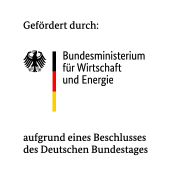Improvement of service life of metallic recirculating radiant heating tubes for industrial furnaces by reducing thermal stresses
The aim of the project was to investigate various internal and external factors influencing the service life of metallic recirculating radiant heating pipes. The temperature distribution on the radiant heating tube surface was calculated by means of CFD simulations, which were able to completely reproduce the thermofluid dynamic phenomena. The boundary conditions for these simulations were generated on a test bench, which also forms the basis for the numerical model. In addition, the calculated temperature distribution can be validated with the measured profile. The flow calculation, which also includes the modelling of the combustion, was coupled with a structural mechanical calculation (FEM) (Fluid Structure Interaction). Thus, the mechanical load of the radiant heating pipes can be calculated in the form of a stress distribution. This result allows a statement to be made about the service life of the furnace components.
The numerical and experimental investigations show that internal and external influencing variables have a large influence on the temperature and stress distribution on the radiant heating tube and thus decisively influence its service life. In comparison to flameless oxidation, standard combustion does not produce any significant differences with respect to the mechanical load of the radiant heating tube under investigation. The design of the bends and the positioning of the burner have a major influence on the flow in the radiant heating tube.
The installation situation of a radiant heating pipe significantly influences the temperature and voltage distribution and thus the service life. When used at lower temperatures, the flow to the pipe should be favourable due to the higher proportion of convective heat flow. The influence of a reduced bandwidth on radiant heating pipes must be taken into account in order to keep the influence on the temperature distribution low. However, it is only possible to predict the service life of furnace components subjected to high thermal loads if transient effects are taken into account. These phenomena will be investigated in a follow-up project (IGF No. 19068 N).
Publications within the project
N. Schmitz, H. Pfeifer: Lebensdauererhöhung metallischer rezirkulierender Strahlheizrohre mit Hilfe experimenteller und numerischer Methoden, Aachen-Freiberg-Magdeburger-Kolloquium, 16.–17.09.2014, Aachen
N.Schmitz, M. Hellenkamp, H. Pfeifer, E. Cresci, J.G. Wünning, M. Schönfelder: Radiant Tube Life Improvement for Vertical Galvanizing Lines, 10th International Conference on Zinc and Zinc Alloy Coated Steel, AIST Galvatech 2015, 31.05.2015–04.06.2015, Toronto, Kanada
Schmitz, N.; Schwotzer, C.; Pfeifer, H.: Erhöhung der Lebensdauer metallischer rezirkulierender Strahlheizrohre, gwi gaswärme international, 66 (2017), Nr. 4 August, S. 49–56

The IGF project 17840 N of the Forschungsvereinigung Forschungskuratorium Maschinenbau e.V. was funded by the AiF within the framework of the programme for the promotion of joint industrial research (IGF) of the Federal Ministry of Economics and Energy on the basis of a resolution of the German Bundestag.
Further information and the final report can be obtained from the Forschungskuratorium Maschinenbau e.V., Lyoner Straße 18, 60528 Frankfurt, Germany or info@fkm-net.de
